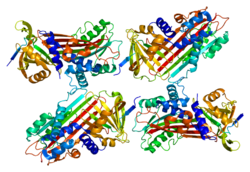Protein C inhibitor (PCI, SERPINA5) is a serine protease inhibitor (serpin) that limits the activity of protein C (an anticoagulant).
An N-terminal fragment of PCI is a possible serum biomarker for prostate cancer.[5]
Protein C inhibitor is activated by heparin against thrombin.[6]
Protein C inhibitor (PCI) is serine protease inhibitor of serpin type that is found in most tissues and fluids, including blood plasma, seminal plasma and urine of human.[7] It is a 52kD glycoprotein and belongs to serine protease inhibitor ( Serpin) super family of protein.[7] In the beginning protein C Inhibitor (PCI) was identified as an inhibitor of activated protein C (APC), it is currently clear that this inhibitor has an expansive specificity, inhibiting several blood coagulation enzymes counting thrombin and factor Xa.[8][9]
- ^ a b c GRCh38: Ensembl release 89: ENSG00000188488 – Ensembl, May 2017
- ^ a b c GRCm38: Ensembl release 89: ENSMUSG00000041550 – Ensembl, May 2017
- ^ "Human PubMed Reference:". National Center for Biotechnology Information, U.S. National Library of Medicine.
- ^ "Mouse PubMed Reference:". National Center for Biotechnology Information, U.S. National Library of Medicine.
- ^ Rosenzweig CN, Zhang Z, Sun X, Sokoll LJ, Osborne K, Partin AW, Chan DW (March 2009). "Predicting Prostate Cancer Biochemical Recurrence Using a Panel of Serum Proteomic Biomarkers". The Journal of Urology. 181 (3): 1407–14. doi:10.1016/j.juro.2008.10.142. PMC 4130150. PMID 19157448.
- ^ Huntington JA (June 2013). "Thrombin inhibition by the serpins". Journal of Thrombosis and Haemostasis. 11 (Suppl 1): 254–64. doi:10.1111/jth.12252. PMID 23809129.
- ^ a b Laurell M, Christensson A, Abrahamsson PA, Stenflo J, Lilja H (April 1992). "Protein C inhibitor in human body fluids. Seminal plasma is rich in inhibitor antigen deriving from cells throughout the male reproductive system". The Journal of Clinical Investigation. 89 (4): 1094–101. doi:10.1172/JCI115689. PMC 442965. PMID 1372913.
- ^ Boulaftali Y, Adam F, Venisse L, Ollivier V, Richard B, Taieb S, Monard D, Favier R, Alessi MC, Bryckaert M, Arocas V, Jandrot-Perrus M, Bouton MC (January 2010). "Anticoagulant and antithrombotic properties of platelet protease nexin-1". Blood. 115 (1): 97–106. doi:10.1182/blood-2009-04-217240. PMID 19855083.
- ^ Pratt CW, Church FC (May 1992). "Heparin binding to protein C inhibitor" (PDF). The Journal of Biological Chemistry. 267 (13): 8789–94. doi:10.1016/S0021-9258(19)50348-9. PMID 1315738.





